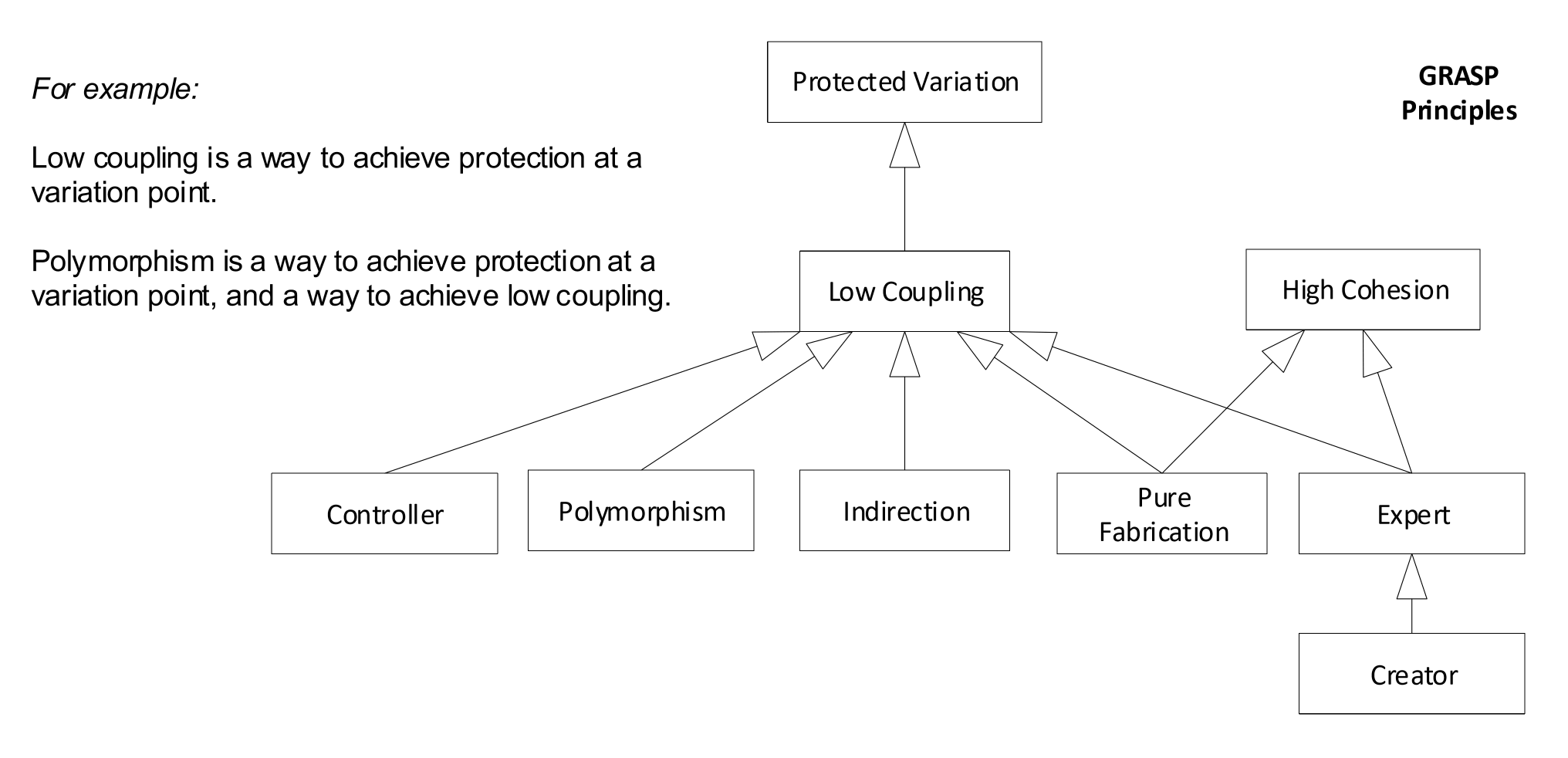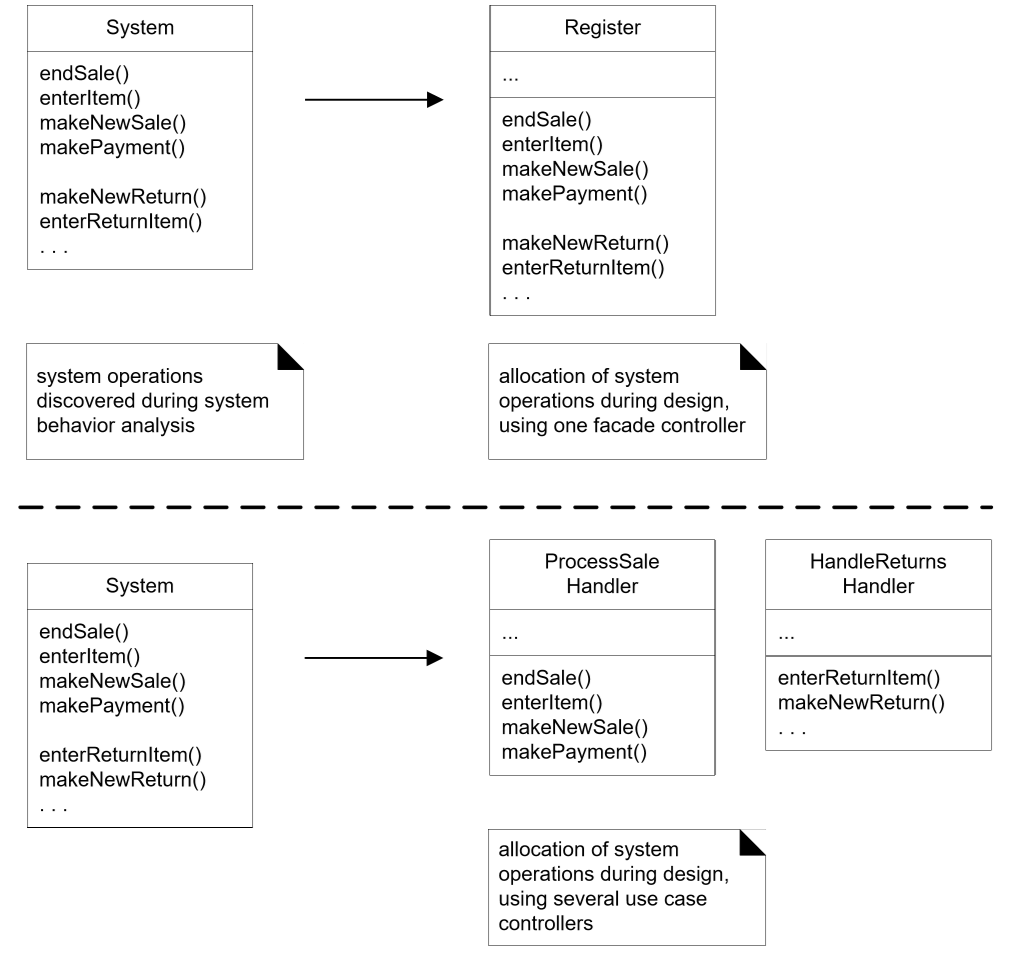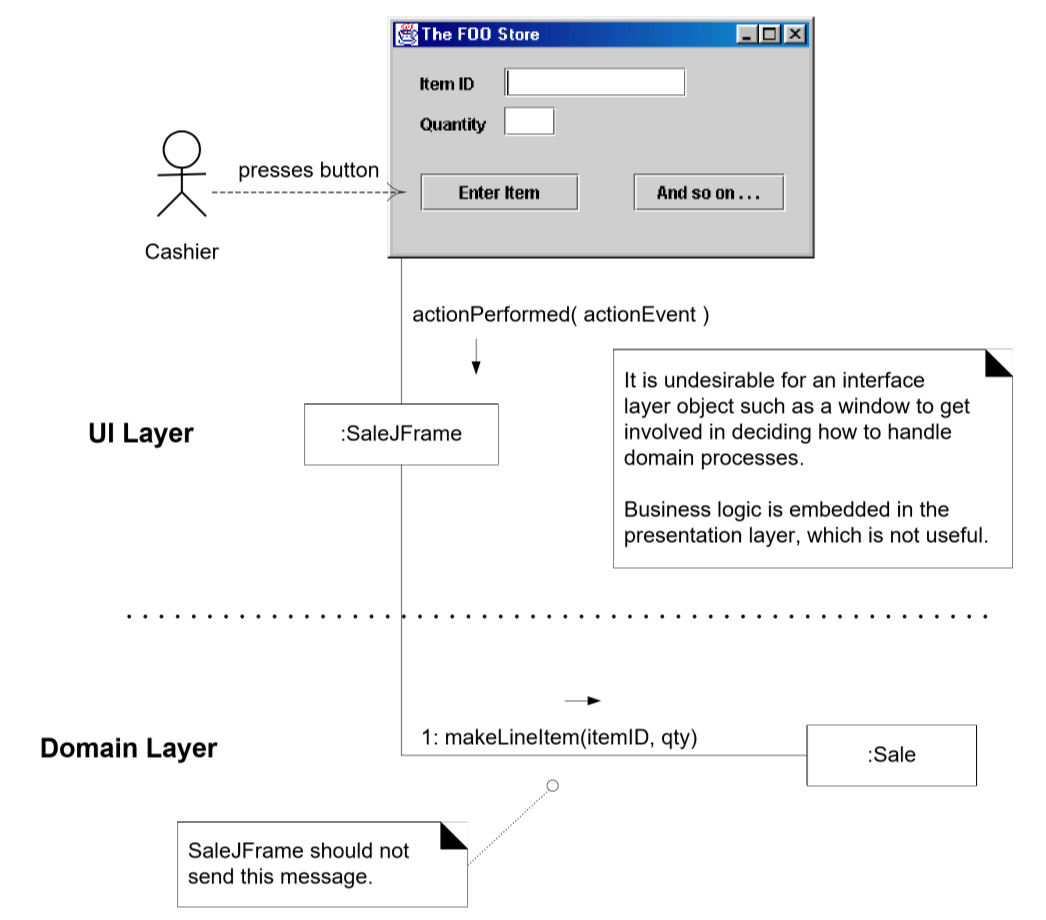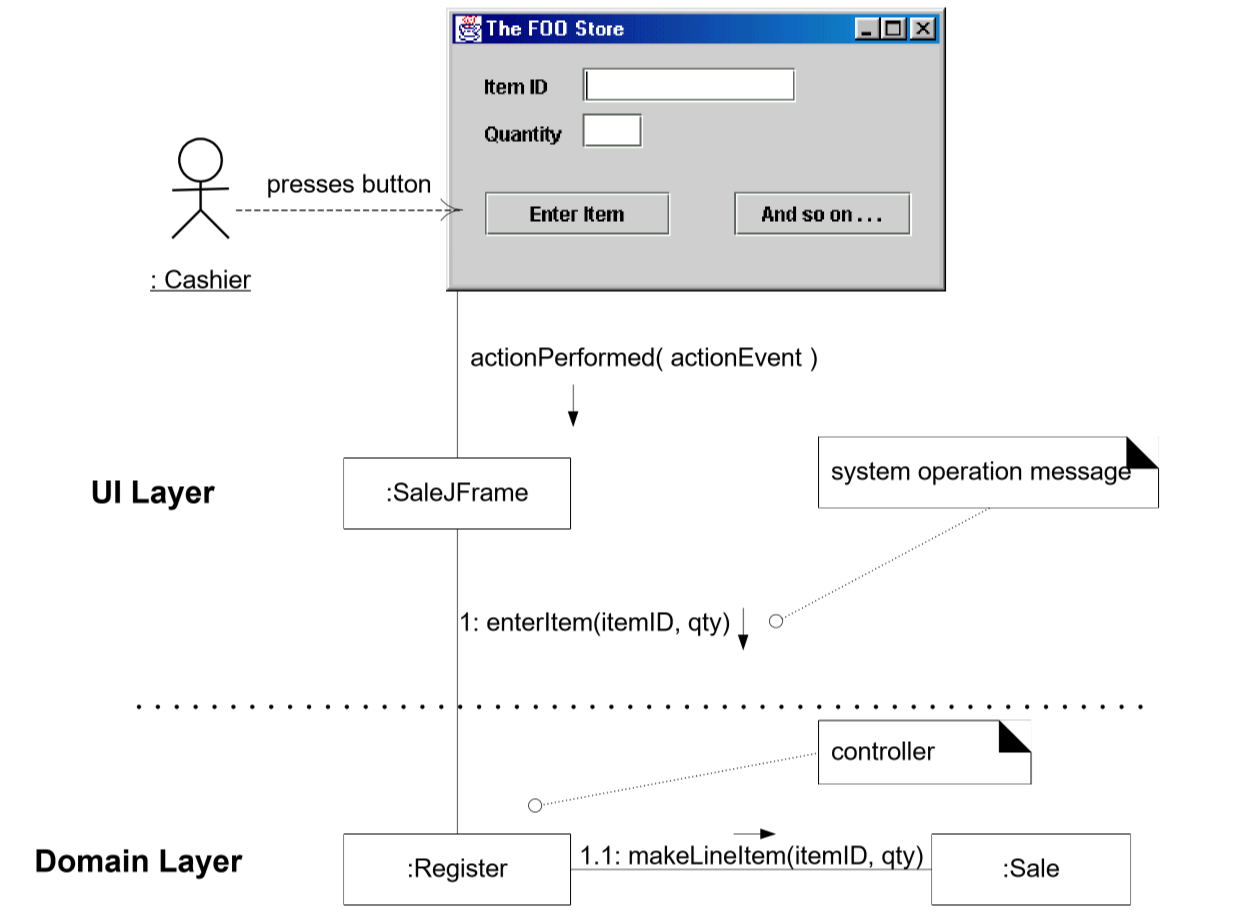Software Modelling and Design
GRASP
GRASP
Table of Contents
- GRASP: Overview and Interrelationship
- Responsibilities
- Creator
- Information Expert
- Low Coupling
- High Cohesion
- Controller
- Polymorphism
- Pure Fabrication
- Indirection
- Protected Variations
GRASP: Overview and Interrelationship
- General Responsibility Assignment Software Patterns
- pattern: named and well-known problem and solution that can be applied to new contexts, providing guidance for assessing trade-offs

Benefits of patterns
- capture expertise in an accessible, standardised manner
- facilitate reuse of applying expertise
- improve understandability and communication, by operating in a common language
- inspiration for new solutions based on modifying existing patterns
Responsibilities
- responsibility: contract/obligation
- types of responsibility:
- doing: an object could
- do something itself, e.g. create an object, perform a calculation
- initiate action in other objects
- control/coordinate activities in other objects
- knowing: an object could
- know about private encapsulated data
- know about related objects
- know about things it can derive/calculate
- doing: an object could
- low representational gap: domain model can be used to inspire knowing responsibilities
- granularity: big responsibilities may take hundreds of classes/methods, while small ones may take a single method
- responsibilities are distinct from methods: responsibilities are an abstraction, but methods fulfill responsibilities
-
collaboration: responsibiilities may involve multiple objects working together to fulfill a responsibility
- Responsibility Driven Design: way to think about assigning responsibilities in OO software design, where the design comprises a community of collaborating responsible objects
Creator
Problem: who should be responsible for object creation?
Solution: Assign class B responsibility to create class A if:
- B contains/aggregates A
- B records A
- B closely uses A
- B has initialising data for A
The more of these that hold, the stronger the implication.
Benefits: Low coupling
Contraindications:
- complex object creation, e.g. from a family of classes. Instead delegate to Factory
Information Expert
Problem: How to decide which class to assign a responsibility to?
Solution:
- Assign X the responsibility if X has the necessary information
Benefits: classes are
- understandable
- maintainable
- extendible
Contraindications:
- the solution suggested by Information Expert may introduce problems with coupling and cohesion
Low Coupling
Problem: how to support low dependency, low change impact, and increased reuse?
Solution:
- assign responsibilities such that coupling remains low.
- use this to differentiate alternatives
- coupling: degree of connection to other elements (whether knowledge/reliance on)
Benefits: code becomes
- maintainable
- efficient
- reusable
Contraindications:
- high coupling can be okay with stable code, e.g. standard libraries
High Cohesion
Problem: How to keep objects focused, understandable, manageable, while suppporting low coupling?
- functional cohesion: how strongly related and focused the responsibilities of an element are
- low cohesion: class performs too many unrelated tasks. Code is hard to comprehend, reuse, maintain
Solution:
- choose between alternatives by assigning the reponsibility to X for maximum cohesion
Benefits: code becomes
- easy to comprehend
- maintainable
- reusable
Contraindications:
- non-functional requirements may require low cohesion, e.g. reduce processing overheads in high- performance computing
Controller
Problem: What first object beyond the UI layer receives and coordinates (i.e. controls) system operation?
Solution:
- facade controller: assign responsibility to a class representing the overall system
- use case/session controller: assign responsibility to a class representing a use case
scenario that deals with the event, named something like
<UseCaseName><Handler|Coordinator|Session>
Benefits: prevent coupling between UI and application logic
Issues:
- bloated controller: controllers with too many responsibilities (low cohesion)
- break facade controller into multiple use case controllers
- delegate work to other objects: only handle control in the controller itself

- Bad coupling of UI to domain layer

- Better UI coupling with controller

Polymorphism
Problem:
- how to handle alternatives based on type (class)?
- conditional variation using
switch-casestatements requires heavy modification when new alternatives are added
- conditional variation using
- how to create pluggable software components?
- viewing components in a client-server relationship, how can you replace a server component without affecting the client?
Solution: when related alternatives/behaviours vary by type (class), assign responibility for the behaviour using polymorphic operations to the types (classes) for which the behaviour varies.
- i.e. give the same name to services in different objects
- i.e. inheritance with generalisation/specialisation, or interfaces
Corollary: avoid testing the type of an object as part of conditional logic to perform varying alternatives based on type (class).
Guideline: unless there is a default behaviour in the superclass, declare a polymorphic
operation in the superclass to be abstract.
Guideline: when should you consider using an interface?
- introduce one when you want to support polymorphism without being committed to a class hierarchy
Benefits:
- easy extension of code: you can introduce new implementations without affecting clients
Contraindications:
- avoid premature optimisation: consider future proofing with respect to realistic likelihood of variability before investing time in increased flexibility.
Pure Fabrication
Problem: what object should have a responsibility, where you don’t want to violate high cohesion/low coupling, etc., but guidance from Expert etc. is not appropriate?
Solution: assign a highly cohesive set of responsibilities to an artificial/convenience class that doesn’t exist in the problem domain.
Benefits:
- high cohesion
- reuse potential
Contraindications:
- overuse where each class is basically a single function: produces high coupling and lots of message passing
Indirection
Problem:
- where to assign responsibility to avoid direct coupling between 2+ things?
- how to decouple to support low coupling and reuse potential?
Solution:
- assign responsibility to an intermediary, creating indirection between components
- e.g.
Adapterto protect inner design against external variation - “Most problems in computer science can be solved by another layer of indirection”
Benefits:
- reduced coupling
Contraindications:
- high performance may need to reduce amount of indirection
- “Most problems in performance can be solved by removing another layer of indirection”
Protected Variations
Problem: How to design objects/systems so that variation in these elements doesn’t impact other elements?
Solution:
- identify points of predicted variation/instability
- assign responsibilities to create a stable interface (in the broad sense of an access view) around them
- points of change:
- variation point: variation in existing system/requirements
- evolution point: speculative variations that may arise in the future
- equivalent to Open-Closed principle: objects should be open for extension, and closed to modification that affects clients
- equivalent to Information Hiding
Benefits:
- extensible
- new implementations don’t affect clients
- low coupling
- low cost of change
Contraindications:
- cost of future-proofing can outweigh benefits
- reworking a brittle design as needed may be easier
Guidance:
- novice developers produce brittle designs
- intermediate developers produce overly fancy/flexible, generalised designs that never get used
- expert developers choose with insight, balancing the cost of changing a simple/brittle design against its likelihood
Liskov Substitution Principle
- software (methods, classes, …) referring to a type
T(interface, abstract superclass) should work properly with any substituted implementation or subclass ofT
Don’t talk to strangers
Avoid creating designs that traverse long object structure paths and/or send messages to distant, indirect (stranger) objects. doing so makes designs fragile with respect to changes in object structures.
Within a method, messages should only be passed to:
thisobject (self)- parameter of the method
- attribute of
this, (or element of collection that is an attribute ofthis) - object created in the method
Intent:: avoid coupling between client and knowledge of indirect objects, and connections between objects.
public void doX() {
// avoid this
F someF = foo.getA().getB().getC().getD().getE().getF();
// this is better
F someF = foo.getFfromFoo();
}
Guideline: The farther along a path one traverses, the more fragile it will be. Instead add a public operation to direct objects that hides how the information is obtained.